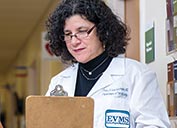Is it time for the medical community to rethink end-of-life health care?
Dr. Paul Marik has outspoken opinions about end-of-life health care in the United States. They can be traced to his experiences as a young physician in his home country of South Africa.
"The indigenous people went home to die," he says. Whereas in America, where he has spent most of his professional career, "people come to the hospitals to die."
Paul Marik, MBBch, the EVMS Foundation Distinguished Professor in Internal Medicine and Professor of Internal Medicine, aired his frustrations in an article he wrote for the American Journal of Hospice and Palliative Medicine titled, "The Cost of Inappropriate Care at the End of Life: Implications for an Aging Population."
"We spend all of this money, and we can't produce reasonable health care. We have a problem, and we've got to fix it."
The Washington Post picked up on Dr. Marik's commentary and published an article that focused on him and his colleagues at EVMS and Sentara Norfolk General Hospital. The pointed headline for that article was "'Warehouses for the dying': Are we prolonging life or prolonging death?"
Concerns about priorities in end-of-life health care come at a time when popular-media publications, as well as reports from professional organizations and government agencies, are framing a new conversation about aggressive care for patients who are not expected to return to a normal quality of life. With the number of people over 65 in the nation expected to double to 70 million by 2030, this conversation takes on added significance.
Dr. Marik, who is also Chief of Pulmonary and Critical Care Medicine in EVMS Internal Medicine, welcomes a critical look by government and society at how the country allocates health-care resources.
"The trajectory now is not a good one," he says. "We spend all of this money, and we can't produce reasonable health care. We have a problem, and we've got to fix it."
According to the latest available data, published for 2013, patients older than 65 make up only 11 percent of the U.S. population, yet they account for 34 percent of the nation's $2.9 trillion in annual health-care expenditures. The country has eight times more Intensive Care Unit (ICU) beds per capita than other Western countries, and elderly patients are now allotted approximately 60 percent of ICU days in U.S. hospitals.


"A disproportionate number of these ICU days are spent by elderly patients before their death," he writes. "In many instances, aggressive life-supportive measures serve only to prolong the patient's death. Such treatment inflicts pain and suffering on the patient (with little prospects of gain) and incurs enormous financial costs to the health-care system."
At the core of Dr. Marik's journal article is the case of an 86-year-old woman who came to the ICU with severe circulatory problems and underwent an aneurysm repair. Complications mounted following the surgery, and after two weeks in the hospital, the patient was assessed by the critical-care team as being in multisystem organ failure, a condition that usually results in death.
Nevertheless, the patient's family asked for aggressive supportive measures to continue. Six weeks later, with no improvement in the patient, the family agreed to comfort-care measures and the patient soon died. Her aggregate hospital charge, according to Dr. Marik's research, was $821,721.
Both Dr. Marik and geriatrician Robert Palmer, MD, cite a failure to communicate among physicians, patients and patients' families as the reason many people do not prepare end-of-life care plans before they get too sick to do so.
"Most Americans do not want to be kept alive by artificial devices," says Dr. Palmer, the John Franklin Chair of Geriatrics, Director of the EVMS Glennan Center for Geriatrics and Gerontology and Professor of Internal Medicine. "Most want to die at home." But living wills and advance directives often are left undone, and people never have an "open and honest conversation about how they want to spend their remaining time," he says.
Still, Dr. Palmer detects in the nation an "awakening of the recognition that death is part of the life cycle. This recognition was the norm before the 20th century," he believes, but was displaced by a cascade of medical advances that have greatly increased life expectancy in America.
Quantity vs. quality of life
When Dr. Marik makes his ICU rounds with students and residents, he routinely sees patients he believes would object — if they had the physical and cognitive faculties to do so — to the masks, hoses, wires and other trappings of life support. It is not uncommon for these patients to have their wrists restrained to keep them from pulling out a breathing tube or intravenous needle.


"The implications of our current practices are enormous," Dr. Marik says. "I'm not saying don't treat the elderly. But don't waste resources, and at the same time be more compassionate."
Dr. Marik believes the "death with dignity" argument has been minimized by common misconceptions. One is that medicine always has an answer — as seen on fictional television shows, he adds — and that death happens because the medical system has failed.
Another is that a family's "do everything you can" request for a severely declining patient is always the most compassionate choice. "This often translates as 'do everything you can' to maintain biological life," he says, "even at the expense of quality of life."
Palliative care — treating symptoms and seeking to make patients comfortable rather than pursuing aggressive treatments — has become a more integrated part of the medical curriculum, thanks in part to Marissa Galicia-Castillo, MD (MD '97, Internal Medicine Residency '00), the Sue Faulkner Scribner Distinguished Professor in Geriatrics and Associate Professor of Internal Medicine.
Much of the population sees palliative medicine as just for the end of life, "but it's so much more," she says. "It can begin anytime in the course of a disease." A recent study, in fact, found that early palliative intervention helped patients live longer than others who opted for aggressive care. "That was a surprise to many."
Dr. Galicia-Castillo serves as the Section Head of Palliative Medicine at the Glennan Center and Medical Director of Palliative Medicine at Sentara Norfolk General. There was no specific palliative care instruction at EVMS when she was a student, but for the past three years, she has co-directed a course on this topic, along with Deborah Morris, MD, Assistant Professor of Internal Medicine, that is required for third-year medical students.
"This is fairly new, yes, but to me it is old-fashioned medicine," Dr. Galicia-Castillo says. "It's really talking to patients, understanding symptoms and understanding what their goals are. That's a throwback."













